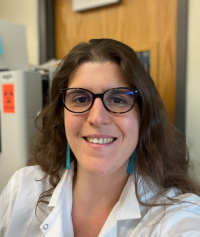
- Name: Sophia Theodossiou, Ph.D.
- Institution: Boise State University
- Department: Mechanical and Biomedical Engineering
- Phone: 208-426-4074
- Email: sophiatheodossiou@boisestate.edu
- Website: https://bsubmel.github.io/webpage/
Summary: Our work in the Biomaterials and Musculoskeletal Engineering Lab (BMEL) is at the convergence of tissue engineering and biomaterials research. We combine stem cells from animal or adult sources with customized biomaterials that deliver tunable and controllable mechanical and biochemical signals. We use our materials to direct cell behavior, with the ultimate goal of regenerating musculoskeletal tissues. We focus on tendon, skeletal muscle, and cartilage, as well as on the mechanically complex interfaces between muscles and tendons, tendons and bones, or muscles and nerves. We occasionally venture outside the musculoskeletal system and build materials for a diverse set of biomedical applications, including bioinks for live cell 3D printing, transdermal delivery of tricky therapeutic payloads, and in vitro modeling of complex disease environments via our silk fibroin hydrogels. If you’re interested in musculoskeletal tissue engineering, biomaterials design and fabrication, or mechanobiology, we are the lab for you!
Minimum Courses: N/A
Projects: Mechanically tunable hydrogels for investigating unique mechanobiological questions – Most 3D cell culture systems used in tissue engineering research have static mechanical properties. In other words, while material characteristics such as stiffness and elastic modulus can be set within specific ranges, the stiffness or modulus cannot change over the course of an experiment. In BMEL, we make custom biomaterials that can stiffen or soften at controllable rates throughout the course of the experiment. Our dynamic materials are a far more accurate representation of the mechanical changes that occur in human tissues during development, injury, or disease. Fellows working on our dynamic materials projects will have the chance to learn how to chemically modify polymers to control the resulting hydrogel mechanical properties, how to mechanically evaluate the resulting constructs, and how to add peptides or other biomolecules to create 3D in vitro culture environments that mimic various disease or developmental stages.
Custom bioinks for live cell 3D printing – The extracellular matrix (ECM), the collection of proteins and other compounds surrounding networks of cells, is an incredible but underutilized source of custom biomaterial building blocks. Using decellularization techniques developed in BMEL, fellows will extract ECM from various musculoskeletal tissues of human and animal origins. Fellows will then use the ECM to develop bioinks that suport live cell 3D printing using one of the custom, low-cost and open-source 3D printers available in our lab. Fellows will learn the basics of live cell 3D printing, bioink fabrication and testing, growth factor supplementation for cell differentiation and patterning, and materials fabrication techniques to enable mechanical gradients in 3D printed constructs.
Microneedles for transdermal delivery of uncommon therapeutic payloads – INBRE fellows will work with graduate students or advanced undergraduate research assistants to chemically modify silk fibroin microneedles that transdermally deliver a variety of therapeutic compounds that are tough to administer orally or via injection. Fellows will learn basic material fabrication and assessment techniques, how to quantify protein encapsulation and release within the microneedles, mechanical testing, and ex vivo drug delivery testing methods
.


